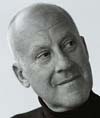 |
New York
Architecture Images-New York Architects Norman Foster |
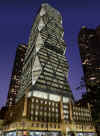 Hearst Magazine Building b. Manchester, England 1935 Norman Foster was born in Manchester, England in 1935. He received his architectural training at Manchester University School of Architecture, which he entered at age 21, and Yale University. He worked with Richard Rogers and Sue Rogers and his wife, Wendy Foster, as a member of "Team 4" until Foster Associates was founded in London in 1967. The "High Tech" vocabulary of Foster Associates shows an uncompromising exploration of technological innovations and forms. The firm's work also shows a dedication to architectural detailing and craftsmanship. Their designs emphasize the repetition of industrialized "modular" units in which prefabricated off-site-manufactured elements are frequently employed. The firm often designs specialist components for individual projects. Foster was awarded the RIBA Royal Gold Medal in 1983, and in 1990 the RIBA Trustees Medal was made for the Willis Faber Dumas building. He was knighted in 1990, and recieved the Gold Medal of the AIA in 1994. On June 7, 1999, Sir Norman received the Pritzer Architecture Prize. Foster and Partners currently has offices in London, Berlin, and Singapore, with over 500 employees worldwide. References Muriel Emmanuel. Contemporary Architects. New York: St. Martin's Press, 1980. ISBN 0-312-16635-4. NA680.C625 1980. p681-682. Details Recipient of the Pritzker Architecture Prize, 1999. Recipient of the American Institute of Architects Gold Medal, 1994. Foster and Partners
Foster and Partners |
|
Norman Foster is considered by many to be the most prominent architect in
Britain, and his presence in the United States has been increasingly
strong. He won the 1999 Pritzker Architecture Prize, his profession's
most prestigious award.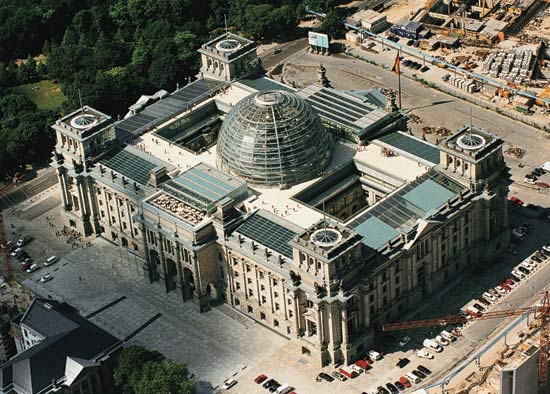 Lord Foster rebuilt the Reichstag as a new German Parliament in Berlin and designed a contemporary Great Court for the venerated British Museum. He linked St. Paul's Cathedral to the Tate Modern with the Millennium Bridge, a slender steel footbridge across the Thames. He designed the Hearst Corporation Building in Manhattan, at 57th Street and Eighth Avenue. 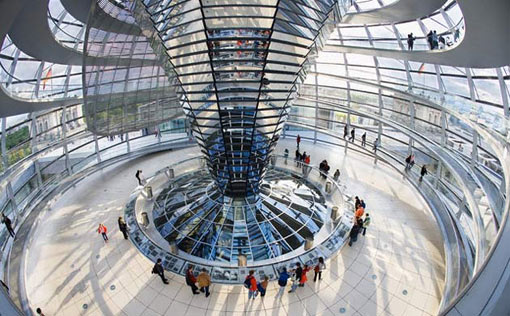 He was born in Manchester, England, in 1935. Among his firm’s many other projects are London’s City Hall, the Canary Wharf Underground Station in London and the renovated courtyard of the Smithsonian American Art Museum and National Portrait Gallery in Washington. 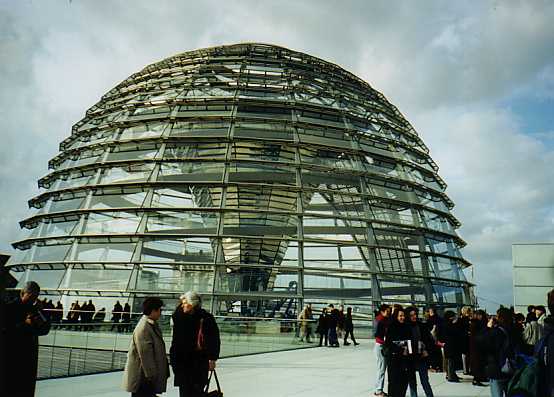 In the 1970s, Lord Foster was one of the most visible practitioners of a high-tech architecture that fetishized machine culture. His triumphant 1986 Hong Kong and Shanghai bank building, conceived as a kit-of-parts plugged into a towering steel frame, was capitalism's answer to the populist Pompidou Center in Paris. Nicolai Ouroussoff, The Times’s architecture critic, has written that although Lord Foster’s work has become sleeker and more predictable in recent years, his forms are always driven by an internal structural logic, and they treat their surroundings with a refreshing bluntness. NYT |
|
|
Select Works 01. Reichstag 02. British Museum Great Court 03. Millennium Bridge 04. Hearst Corporation Building 05. London’s City Hall 06. Canary Wharf Underground Station 07. Smithsonian American Art Museum 08. National Portrait Gallery in Washington 09. 1986 Hong Kong and Shanghai bank building |
|
|
links |
www.fosterandpartners.com |